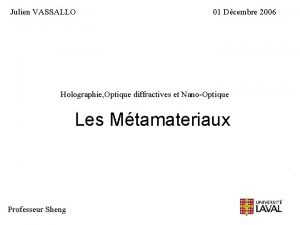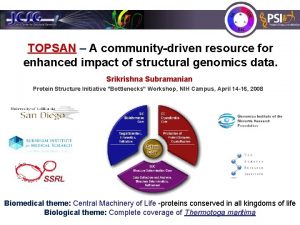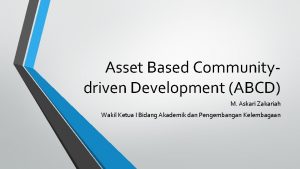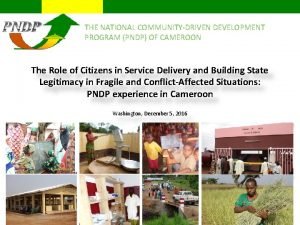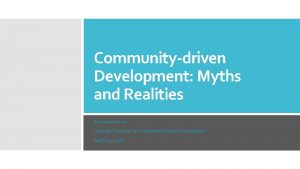The Impact of CommunityDriven Development Existing Evidence Julien

















- Slides: 17

The Impact of Community-Driven Development: Existing Evidence Julien Labonne, Social Development Department Malte Lierl, Africa Impact Evaluation (AIM), World Bank

Presentation Outline • Why participatory development • Evidence on participatory development • Knowledge gaps-many Picture from : Guinea PACV Picture from : http: //kalahi. dswd. gov. ph/Photo. Gal/ 2

Why participatory development? • Local information/knowledge • Existing community norms • Interests of beneficiaries Participatory provision of public goods and services LEARNING Community mobilization, BY training, facilitation DOING Increased welfare Institution building social cohesion social accountability 3

How does this fit into the larger governance agenda? Central government • Fiscal decentralization • Functional decentralization Local government • Budget decisions • Service delivery Community participation • Social monitoring • Demand for services 4

What questions arise from this scheme? 1. Effectiveness of CDD—good IE evidence – – Welfare effects Targeting and elite capture 2. How does CDD compare with other delivery modes? —no IE evidence (only observational) – – Implementation performance Sustainability 3. What are the best ways to structure community participation? – – – Institutional arrangements Extent of facilitation Information 4. Does CDD improve accountability of local governance? – Ownership/satisfaction 5. Does CDD improve social cohesion? 5

1. Effectiveness of CDD: welfare effects – impact evaluation results • Welfare – Education: • Increases in school enrollment rates (Armenia, Nicaragua and Zambia) • Increases in total years of schooling (Honduras, Nicaragua, Peru and Zambia) • Positive impacts on health and education outcomes as well as on access to roads. (Lao PDR – PRF) – Health: • Significant declines in infant and child mortality rates (Bolivia) • Large positive impacts on nutritional status of children (esp. in poor households). (Senegal PNIR) • Significant declines in infant and child mortality rates (Bolivia and Peru) 6

Cont 1. Effectiveness of CDD: welfare effects – Income and consumption: • Consumption increases among poor households in project area (Indonesia KDP) • Dosage effect: larger increases with longer involvement (Indonesia KDP) • Large investments required to join user groups prevented the program from having a significant impact on women and the poor (Nigeria Fadama II) 7

Cont 1. Effectiveness of CDD: Elite capture – India • Inequality does not affect elite capture of private goods allocation within villages, but unequal villages receive less resources from higher levels of government. (Bardhan & Mookherjee, 2006) – Ecuador FIS • Pro-poor projects more likely in poorer communities • Pro-poor projects less likely in more unequal communities – Jamaica SIF • 80% of households satisfied with the project outcome • Process dominated by a small group of motivated individuals 8

Cont 1. Effectiveness of CDD: Elite capture – Indonesia KDP • Women’s projects match women’s preferences • general projects match men’s preferences – Philippines KALAHI-CIDSS • Households that were already involved in community affairs have a greater say – India • Lack of information on the community-level benefits of sanitation to the poor caused inefficient targeting decisions 9

2. How does CDD compare ? • NB. There are no good studies with an adequate comparison group • Savings claimed compared to cost “norms”. These savings do not account for local costs. Philippines – Road construction 50 -90% cost reduction Indonesia – Road/bridge construction 36% cost reduction Burkina Faso – school buildings 40% cost reduction • Quality in technical reviews Indonesia KDP sub-projects 70. 7% of satisfactory technical quality Burkina Faso – CBRDP sub-projects 90% of satisfactory technical quality • Are these numbers high or low? Compared to what? We don’t know if CDD is more cost effective than centralized delivery 10

Cont 2. How does CDD compare: investments rates of return? • High Internal Rates of Return – Philippines MRDP: 12% roads, 47% water supply – Philippines KALAHI-CIDSS: 19 -22% roads, 58 -65% water supply, 20% health centers – Indonesia KDP: 52% roads, 39% water supply, 68% irrigation 11

Cont 2. How does CDD compare: sustainability of service delivery Anecdotal evidence suggests that better links to local government improves maintenance – Philippines MRDP & ARCDP • LGU held accountable for maintenance – Cambodia SEILA • 75% sustainable maintenance plan, but 37% of projects needed maintenance 12

3. Best ways to structure community participation: Knowledge and Information Matter • A newspaper campaign drastically reduced embezzlement of school grants in Uganda (Reinikka & Svensson, 2003) • Community-based monitoring in Uganda leads to large increases in the utilization of health services, and improvements in health outcomes (Björkman & Svensson, 2007) • Knowledge of ways to report public officials’ behavior and poor service reduces corruption and increases service quality. (Deininger & Mpuga, 2005) • Participation in social and information networks increases demand for public goods in Benin (Wantchekon, 2003; Wantchekon & Vermeersch, 2005) • Publication of corruption audits has strong impact on chances for reelection of local politicians in Brazil. Radio is the most effective instrument. (Ferraz & Finan, 2005) 13

4. Does CDD increase social accountability? • Legitimacy of local governance decisions – Indonesia KDP (Olken, 2008): • Direct community voting on local development decisions increased satisfaction • Decisions taken were similar to those made by elected representatives • Accountability – Indonesia KDP: • No conclusive evidence of the effect of social monitoring on locallevel corruption • Increasing the probability of audits to 100% had a large impact in reducing corruption. 14

5. Does CDD increase social cohesion? • Indonesia (Barron et al. , 2007) – Qualitative research provides a strong indication that KDP is effective at mitigating local conflict. • Liberia (Fearon, Weinstein, Humphreys, 2009) – The Lofa county CDR program increased individual contributions to local public goods by 6. 5 % • Philippines (Chase and Labonne, 2008) – Kalahi project associated with increased participation in village assemblies, but decreased participation in informal community activities (collective action and group membership) – Significantly increased self-reported trust to strangers, but potentially decreased trust to neighbors • How do we make sense of these mixed results? 15

Knowledge Gaps • How does CDD compare to centralized service delivery mechanisms across different institutional environments; local government delivery? • To what extent is the impact of CDD owed to the participatory process and to what extent is it a result of funding support? • What models of community participation mobilize response and secure results? • Does participation of local advocacy groups in monitoring of service delivery improve local accountability or does it distract from their core function of giving a voice to vulnerable groups? • What models of community decision-making are most effective at conflict resolution?

Thank you!
 Example of a warrant in writing
Example of a warrant in writing What is a primary source
What is a primary source Primary evidence vs secondary evidence
Primary evidence vs secondary evidence Secondary sources
Secondary sources Primary evidence vs secondary evidence
Primary evidence vs secondary evidence Primary evidence vs secondary evidence
Primary evidence vs secondary evidence Fiber evidence can have probative value.
Fiber evidence can have probative value. Class evidence vs individual evidence
Class evidence vs individual evidence Difference between class and individual evidence
Difference between class and individual evidence Class vs individual evidence
Class vs individual evidence The absence of evidence is not evidence of absence meaning
The absence of evidence is not evidence of absence meaning Mariette julien
Mariette julien Julien vassallo
Julien vassallo A quoi sert cette chanson si elle est désarmée
A quoi sert cette chanson si elle est désarmée Julien conti
Julien conti Marc antoine jullien de paris
Marc antoine jullien de paris Julien mieral
Julien mieral Julien aymeric simonnet
Julien aymeric simonnet












